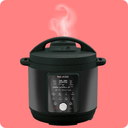Pressure cookers are popular for many reasons. They cook food faster than traditional cooking methods, whilst using less energy. But how do they work? In this blog we will answer this frequently asked question and shine some light on why pressure cookers are used and loved by many people.

Sealed Environment
The core principle behind a pressure cooker is its ability to seal the cooking environment. The lid of a pressure cooker is designed with a rubber or silicone gasket, making it airtight. This seal prevents the escape of air or liquids once it is tightly locked.
Rising Pressure
When you heat the pressure cooker, the liquid inside begins to boil. Because the steam cannot escape, it accumulates within the pot. This build-up of steam increases the pressure inside the cooker.
Steam Cooking
The steam that builds up is forced back into the food, helping it cook quickly and evenly. This method is excellent for cooking tougher cuts of meat, legumes, and stews, as the high heat and pressure help break down fibres faster than traditional boiling or baking.
Regulating Pressure
Pressure cookers have a valve that maintains pressure at a pre-set level. If the pressure exceeds this level, the valve releases some steam to stabilise the internal environment. This is crucial for safety and ensures that the pressure doesn’t build to dangerous levels.
Increased Cooking Temperature
Under higher pressure, the boiling point of water increases. Normally, water boils at 100°C, but in a pressure cooker, it can boil at up to around 120°C. This higher temperature cooks food faster.
Faster Cooking Times
Due to the increased temperature and pressure, cooking times in a pressure cooker are significantly reduced—sometimes by up to 70%. This makes it a highly efficient cooking method, both in terms of time and energy.
Enhanced Flavours
Cooking in a pressure cooker can also intensify flavours, as the steam recondenses into the food, and none of the moisture is lost during cooking.

